 HOME: www.hiltonpond.org |
|||
 HOME: www.hiltonpond.org |
|||
(Back to Preceding Week; on to Next Week)
|
AUTUMN BUTTERFLIES When we think of butterflies, we usually associate them with "lazy, hazy, crazy" days of summer, when flowers are plentiful and these graceful, colorful insects flutter gracefully from blossom to blossom. Nonetheless, here at Hilton Pond Center we've seen a few butterflies even on warm days in the dead of winter, so it's not surprising there would be several species still flitting around at the end of October. Down in our favorite Goldenrod patch--which this late in the season has actually become a white aster meadow--we found numerous little butterflies probing for nectar, and most were new to the Center's Butterfly Checklist. 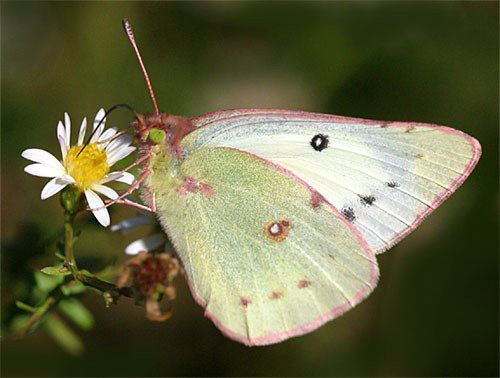
All text & photos © Hilton Pond Center As of 31 October 2003, the tally of butterflies we've identified around Hilton Pond stands at 27. This isn't a very big number, and it almost certainly doesn't indicate the true diversity of butterflies that occur locally. Instead, it reflects our lack of expertise at differentiating one butterfly species from another. For us, most butterflies are small and fast and look hopelessly alike--which we suppose is exactly what we said about birds when we started studying them more than 25 years ago. Determined to overcome our deficiencies at identifying butterflies--and thanks to a small equipment grant--we recently ordered a 180mm macro lens for our digital SLR camera, thinking if we captured our Hilton Pond species photographically we might finally begin to understand the nuances of butterfly identification. The lens came this week and, we're relieved to say, our strategy of collecting local butterfly images to help us identify local butterflies is working. Sort of. Except for the Skippers.
Thrice this week we journeyed out to our Goldenrod/Aster meadow, waiting until early afternoon when the sun finally peeked over several tall Eastern Red Cedars that border it. Each day we staked out what looked like a particularly vibrant clump of asters and waited for a nectar- seeking butterfly to land on it. This method worked pretty well, but we also kept an eye open for the arrival of new butterflies and changed position to takes shots of various individuals if they visited other microhabitats. Over a total of about four hours we were able to photograph what looked like eight different butterfly species, most with the good magnification one would expect from a 180mm macro lens. When we brought the camera back to the old farm house at Hilton Pond Center, we downloaded the images onto our trusty Macintosh and were generally pleased at what we saw on the monitor. On Day One we got good exposures of a yellow and white butterfly (top photo)--a female Orange Sulfur, Colias eurytheme. Another photo (just above) is of a female Common Checkered-Skipper, Pyrgus communis, which also matched up nicely with illustrations in our reference books. Yes, we were pleased with our initial progress--but only until we tried to figure out what else we had photographed. Skippers are small butterflies with an attitude. They are the Whirligig Beetles of the butterfly world, moving about in rapid and erratic ways, stopping long enough to entice us to take a photo and then darting off in herky-jerky flight just as we get the camera in focus. Maybe the secret is to photograph Skippers early on chilly fall mornings while their joints are still stiff. It turns out we WERE fast enough to snap an exposure or two of several different Skippers at Hilton Pond Center, but it didn't matter; when we looked at our photos, they either looked to us like NONE of the Skippers in the field guide, or like ALL of them. In our opinion, Skippers are to butterflies as "confusing fall warblers" are to birds. To be honest, slower-moving Skippers such as the aforementioned Common Checkered-Skipper are actually pretty easy to figure out. Likewise, the azure blue abdomen and extended hindwings of a Long-tailed Skipper, Urbanus proteus (above right), make it hard to confuse with anything else. And even though several kinds of Skippers are bright orange or yellow, the forewing spot pattern and greenish back hair (below) of the male Fiery Skipper, Hylephila phyleus, are a dead giveaway.
For the rest of the Skippers we photographed (see below), we feel almost helpless and look forward to sitting soon at the foot of some Butterfly Guru who can enlighten us on how to ID a Skipper from a photo, much less in the field. Is one a Clouded Skipper, maybe? Or is it Cloudless? A Leonard's? Or some kind of Roadside-Skipper? Did we mention that male and female Skippers of the same species sometimes look very different? Or that a Skipper species' appearance can vary significantly through its geographic range? And while we're asking questions, maybe the lepidoptera expert can tell us why most Skippers sit with hindwings flat and forewings at 45-degree angles. Perhaps to insure an even faster get-away that frustrates us further? Fortunately, now that October has ended and cold weather approaches, we've got most of the winter to get better at using our new macro lens and to work on identifying Autumn Butterflies. UNfortunately, we fear that just as we figure out those fast fall flyers we photographed, March will arrive at Hilton Pond Center and bring a whole different complement of confusing SPRING Skippers! 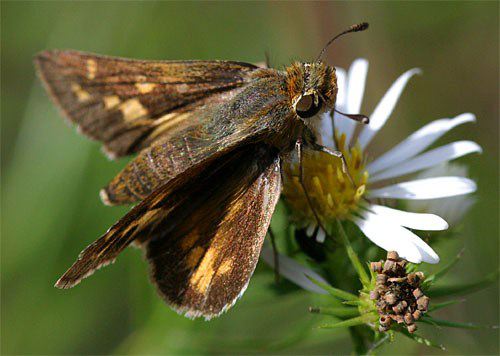 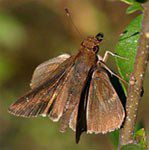 ... ...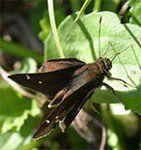 ... ...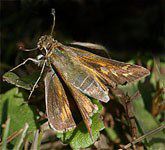
All text & photos © Hilton Pond Center Comments or questions about this week's installment? NOTE: Be sure to scroll down for an account of all birds banded or recaptured during the week, as well as some other interesting nature notes. "This Week at Hilton Pond" is written & photographed You may wish to consult our Index of all nature topics covered since February 2000. You can also use the on-line Search Engine at the bottom of this page. For a free, non-fattening, on-line subscription to "This Week at Hilton Pond," just send us an E-mail with SUBSCRIBE in the Subject line. Please be sure to configure your spam filter to accept E-mails from hiltonpond.org. |
|
Make direct donations on-line through
Network for Good: |
|
|
LIKE TO SHOP ON-LINE?
Donate a portion of your purchase price from 500 top on-line stores via iGive: |
|
|
Use your PayPal account to make direct donations:
|
|
|
|
|
SPECIES BANDED THIS WEEK: * = New species for 2003 WEEKLY BANDING TOTAL 6 species 9 individuals
YEARLY BANDING TOTAL (2003) 60 species 981 individuals
BANDING GRAND TOTAL (since 28 June 1982) 123 species 43,095 individuals
NOTABLE RECAPTURES THIS WEEK (with original banding date, sex, and current age) Carolina Chickadee (1) 07/08/02--2nd year unknown Carolina Wren (1) White-throated Sparrow (1)
VAGRANT HUMMINGBIRDS --A hatch-year female Rufous Hummingbird was banded on 24 Oct at Rock Hill SC in the same yard where a second-year female was banded in Jan 2003. --A hatch-year female Rufous Hummingbird was banded at Todd NC on 26 Oct. |
OTHER SIGHTINGS OF INTEREST 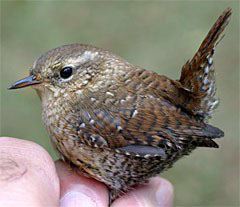 --You know it must be late October at Hilton Pond when the assortment of birds banded includes our seventh-ever Winter Wren (above), a Ruby-crowned Kinglet, White- throated Sparrows, and . . . our first Yellow-billed Cuckoo since 1998 (below).  --On 22-23 Oct, two groups of students (grades 1-4) from Chesterbrook Academy in Charlotte NC visited Hilton Pond Center for Guided Field Trips. (See photo below of the younger kids posing with a male Northern Cardinal in-the-hand and learning to say "Whitewash!" instead of "Cheese!" for the camera because the bird had just left a little care package on the steps.) All students on both days were intensely curious and very interested in our local habitats and bird life, and several mentioned it was the very first time they'd ever had a chance to "go to the woods." We're glad we were able to provide them with their initial opportunity to see "real nature" up close. |
|
All text & photos © Hilton Pond Center |
|
|
|
Up to Top of Page Current Weather Conditions at Hilton Pond Center |
 You can also post questions for The Piedmont Naturalist |
Join the |
Search Engine for |
|
|